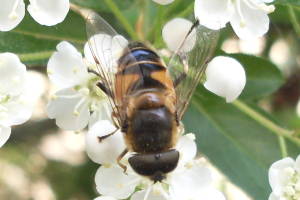Cu
Nel sistema Comstock-Needham è il nome abbreviato con cui si indica la quinta nervatura longitudinale in senso antero-posteriore, posizionata fra M e A e primitivamente suddivisa in due rami, anteriore (CuA) e posteriore (CuP) (Colless & McAlpine, 1970; Servadei et al., 1972; McAlpine, 1981; Tremblay, 1985; Merz & Haenni, 2000; Amorim & Rindal, 2007; Cumming & Wood, 2009; Cerretti, 2010).
Nei Ditteri, secondo l'interpretazione di Comstock (1918b), il ramo anteriore CuA si suddivide a sua volta in due rami (CuA1 e CuA2 sensu McAlpine, 1981), di cui il primo si fonde con M4 (McAlpine, 1981), mentre il ramo posteriore CuP è assente o ridotto ad una piega longitudinale (vedi falsa vena). Questa interpretazione, sostenuta da Hennig (1954), è ampiamente diffusa nella letteratura recente (McAlpine, 1981; Matile, 1993; Merz & Haenni, 2000; Cumming & Wood, 2009; Cerretti, 2010). Analoga interpretazione è data da Hewitt (1914), che indicava la quinta nervatura logitudinale dell'ala della mosca domestica come derivata dalla fusione del ramo anteriore di Cu con la vena M3.
Secondo l'interpretazione di Tillyard, 1926, invece, il ramo anteriore non è suddiviso ed è pertanto distinto dalla vena M4. Questa interpretazione, sostenuta in passato da Alexander (1919, 1929) e Colless & McAlpine (1970), è condivisa anche da altri Autori nella letteratura recente (Byers, 1989; Krzemiński & Judd, 1997; Saigusa, 2006; Amorim & Rindal, 2007).
Come sinonimo del nome abbreviato, Comstock (1918a) propose anche la denominazione cubito sensu Redtenbacher (1886), ampiamente usata in letteratura.
Sinonimi:
- cu (Hennig, 1954);
- Cubito (sost.) o cubitale (agg.) sensu Redtenbacher e Comstock (Hewitt, 1914; Hennig, 1954; Servadei et al., 1972; McAlpine, 1981; Tremblay, 1985; Matile, 1993; Merz & Haenni, 2000; Cumming & Wood, 2009).

Riferimenti bibliografici
- Alexander, C.P. (1919). The wings and their venation: 860-869. In The Crane-flies of New York: Part I. Distribution And Taxonomy of the Adult Flies, Ithaca: The University.
- Alexander, C.P. (1929). A comparison of the systems of nomenclature that have been applied to the radial field of the wing in the Diptera. Proceedings of the Fourth International Congress of Entomology (Ithaca, 1928) 2: 700-707.
- Amorim, D.S. & Rindal, E. (2007) Phylogeny of the Mycetophiliformia, with proposal of the subfamilies Heterotrichinae, Ohakuneinae, and Chiltrichinae for the Rangomaramidae (Diptera, Bibionomorpha). Zootaxa 1535: 1-92.
- Byers, G.W. (1989) Homologies in wing venation of primitive Diptera and Mecoptera. Proceedings of the Entomological Society of Washington 91: 497-501.
- Cerretti, P. (2010) Terminologia morfologica: 8-11. In I tachinidi della fauna italiana (Diptera Tachinidae), con chiave interattiva dei generi ovest-paleartici. Vol. II. Atlante iconografico. Centro Nazionale Biodiversità Forestale - Verona. Cierre Edizioni, Verona.
- Colless, D.H. & McAlpine, D.K. (1970) Diptera (Flies): 656-740. In The Insects of Australia. Melbourne University Press, Carlton, Victoria.
- Comstock, J.H. (1918a) The more general features of the wings of Insects: 52-83. In The Wings of Insects. An Exposition of the Uniform Terminology of the Wing Veins of Insects and a Discussion of the More General Characteristics of the Wing of the Several Orders of Insects. The Comstock Publishing Company, Ithaca, New York.
- Comstock, J.H. (1918) The Wings of Diptera: 347-361. In The Wings of Insects. An Exposition of the Uniform Terminology of the Wing Veins of Insects and a Discussion of the More General Characteristics of the Wing of the Several Orders of Insects. The Comstock Publishing Company, Ithaca, New York.
- Cumming, J.M. & Wood, D.M. (2009) Chapter 2: Adult Morphology and Terminology: 9-50. In Brown, B.V.; Borkent, A.; Cumming, J.M.; Wood, D.M.; Woodley, N.E. & Zumbado, M.A. (a cura di) Manual of Central American Diptera. . Volume 1. National Research Council (Canada) Research Press. ISBN 0660198339.
- Hennig, W. (1954) Flügelgeäder und System der Dipteren unter Berücksichtigung der aus dem Mesozoikum berschriebenen Fossilien. Beiträge Zur Entomologie 4 (3-4): 245-388.
- Hewitt, C.G. (1914) Chapter II. The external structure of Musca domestica. The wings: 23-26. In The House-Fly. Cambridge University Press.
- Krzemiński, W. & Judd, D.D. (1997) Family Tanyderidae: 281-290. In Papp, L. & Darvas, B. (a cura di) Contributions to a Manual of Palaearctic Diptera (with special reference to flies of economic importance). Volume 2. Nematocera and Lower Brachycera. Science Herald, Budapest, Hungary. ISBN 963 04 8837 X.
- Matile, L. (1993) Les Diptères d'Europe Occidentale. Tome I. Société Nouvelle des Editions Boubée, Paris, France. ISBN 2-85004-075-4.
- McAlpine, J.F. (1981) Morphology and terminology - Adults: 9-63. In McAlpine, J.F.; Peterson, B.V.; Shewell, G.E.; Teskey, H.J.; Vockeroth, J.R.; Wood, D.M. (a cura di) Manual of Nearctic Diptera. Volume 1. Research Branch, Agriculture Canada, Monograph N. 27, Ottawa, Canada. ISBN 0-660-10731-7.
- Merz, B. & Haenni, J.P. (2000) Morphology and terminology of adult Diptera (other than terminalia): 21-51. In Papp, L. & Darvas, B. (a cura di) Contributions to a Manual of Palaearctic Diptera. Volume 1. General and Applied Dipterology. Science Herald, Budapest, Hungary. ISBN 963 04 8839 6.
- Redtenbacher, J. (1886) Vergleichende Studien über das Flügelgeäder der Insecten. Annalen des K.K. Naturhistorischen Hofmuseums 1 (3): 152-232.
- Saigusa, T. (2006) Homology of Wing Venation of Diptera. Private publication, Fukuoka, Japan.
- Servadei, A.; Zangheri, S. & Masutti, L. (1972) Entomologia agraria ed applicata. CEDAM, Padova.
- Tillyard, R.J. (1926) The Insects of Australia and New Zealand. Angus and Robertson, Sydney.
- Tremblay, E. (1985) Entomologia applicata. Volume Primo: Generalità e mezzi di controllo. 3 ed. Liguori Editore, Napoli. ISBN 88-207-0681-4.
Licenza Creative Commons BY-NC-SA
(BY: Attribuzione - NC: Non commerciale - SA: Condividi allo stesso modo).

